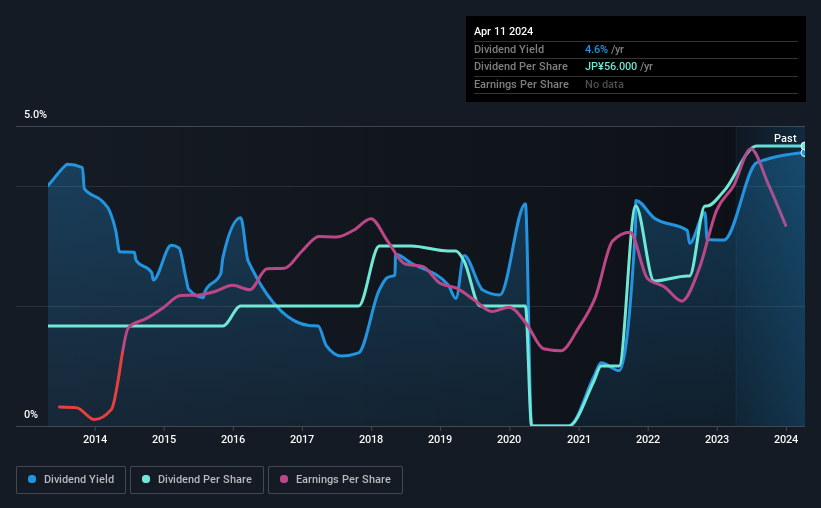Sumida Corporation's (TSE:6817) investors are due to receive a payment of ¥26.00 per share on 28th of August. This takes the dividend yield to 4.6%, which shareholders will be pleased with.
Check out our latest analysis for Sumida
Sumida's Earnings Easily Cover The Distributions
Impressive dividend yields are good, but this doesn't matter much if the payments can't be sustained. Before making this announcement, Sumida was easily earning enough to cover the dividend. This means that most of what the business earns is being used to help it grow.
Over the next year, EPS could expand by 11.5% if recent trends continue. If the dividend continues on this path, the payout ratio could be 33% by next year, which we think can be pretty sustainable going forward.

Dividend Volatility
The company's dividend history has been marked by instability, with at least one cut in the last 10 years. The annual payment during the last 10 years was ¥20.00 in 2014, and the most recent fiscal year payment was ¥56.00. This means that it has been growing its distributions at 11% per annum over that time. Dividends have grown rapidly over this time, but with cuts in the past we are not certain that this stock will be a reliable source of income in the future.
The Dividend Looks Likely To Grow
Given that the dividend has been cut in the past, we need to check if earnings are growing and if that might lead to stronger dividends in the future. It's encouraging to see that Sumida has been growing its earnings per share at 11% a year over the past five years. With a decent amount of growth and a low payout ratio, we think this bodes well for Sumida's prospects of growing its dividend payments in the future.
An additional note is that the company has been raising capital by issuing stock equal to 20% of shares outstanding in the last 12 months. Regularly doing this can be detrimental - it's hard to grow dividends per share when new shares are regularly being created.
We Really Like Sumida's Dividend
In summary, it is always positive to see the dividend being increased, and we are particularly pleased with its overall sustainability. The company is easily earning enough to cover its dividend payments and it is great to see that these earnings are being translated into cash flow. All of these factors considered, we think this has solid potential as a dividend stock.
Investors generally tend to favour companies with a consistent, stable dividend policy as opposed to those operating an irregular one. Meanwhile, despite the importance of dividend payments, they are not the only factors our readers should know when assessing a company. For instance, we've picked out 3 warning signs for Sumida that investors should take into consideration. Is Sumida not quite the opportunity you were looking for? Why not check out our selection of top dividend stocks.
New: Manage All Your Stock Portfolios in One Place
We've created the ultimate portfolio companion for stock investors, and it's free.
• Connect an unlimited number of Portfolios and see your total in one currency
• Be alerted to new Warning Signs or Risks via email or mobile
• Track the Fair Value of your stocks
Have feedback on this article? Concerned about the content? Get in touch with us directly. Alternatively, email editorial-team (at) simplywallst.com.
This article by Simply Wall St is general in nature. We provide commentary based on historical data and analyst forecasts only using an unbiased methodology and our articles are not intended to be financial advice. It does not constitute a recommendation to buy or sell any stock, and does not take account of your objectives, or your financial situation. We aim to bring you long-term focused analysis driven by fundamental data. Note that our analysis may not factor in the latest price-sensitive company announcements or qualitative material. Simply Wall St has no position in any stocks mentioned.
About TSE:6817
Sumida
Designs, manufactures, and sells electronic components and modules for consumer electronics, automotive, and industrial application in Japan, rest of Asia, Europe, and North America.
Established dividend payer with proven track record.
Similar Companies
Market Insights
Community Narratives



